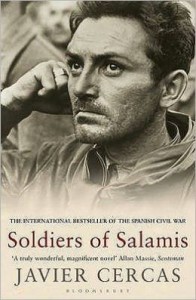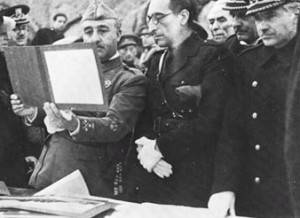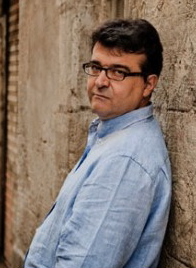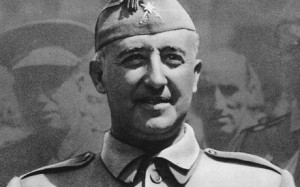Note: This novel was WINNER of the Salambo Prize for Fiction in Spain in 2001 and WINNER of the Independent Foreign Fiction Prize in the UK in 2004. It was also NOMINATED for the IMPAC Dublin Award.
“There are no heroes in peacetime… no living heroes.”
 In this unusual metafictional novel of the Spanish Civil War, author Javier Cercas experiments with the voice of his main character and with the form of this novel, which he describes as “a compressed tale except with real characters and situations, like a true tale.” The unnamed speaker, a contemporary journalist in his forties, is investigating the story of Rafael Sanchez Mazas, a “good, not great” writer of the 1930s, who, in the final days of the Civil War (1936 – 1939) escaped a firing squad and lived to play a role in Franco’s Nationalist government.
In this unusual metafictional novel of the Spanish Civil War, author Javier Cercas experiments with the voice of his main character and with the form of this novel, which he describes as “a compressed tale except with real characters and situations, like a true tale.” The unnamed speaker, a contemporary journalist in his forties, is investigating the story of Rafael Sanchez Mazas, a “good, not great” writer of the 1930s, who, in the final days of the Civil War (1936 – 1939) escaped a firing squad and lived to play a role in Franco’s Nationalist government.
The speaker believes that “forest friends” may have helped Sanchez Mazas survive the end-of-the-war turmoil, and he becomes obsessed with locating them, identifying the Popular front soldier who chose not to reveal Sanchez Mazas’s whereabouts, and learning why these “forest friends” behaved as they did. As he investigates the story of Sanchez Mazas and the complex political alliances of the Civil War, the speaker realizes that he actually knows very little about this complex war, “not much more than I know about the battle of Salamis.”
The speaker, who is obviously Javier Cercas himself, soon begins to expand the scope of his tale, investigating more than the facts about Sanchez Mazas and musing philosophically about the passage of time, the transience of youth, the dubious legacy of war, and the nature of heroes. Wartime heroes live only as long as their friends remember them, and lives and memories are short: one must seize the moment and dance a paso doble in the time available.

Gen. Franco (left) with Rafael Sanchez Mazas (center) as they examine a document about the church’s role in fascism.
The complex history of the Spanish Civil War in the first part of the novel is slow, full of unfamiliar names, places, and political alliances, but as the story of Sanchez Mazas and the people involved with him unfolds, the reader gradually becomes involved with the action and warms to the speaker’s quest to learn everything he can about the incident in the forest.
The scenes near the end of the book, set in a nursing home, are full of touching and emotional realizations, conveying powerful, universal messages about war and heroes from one generation to another (and to the reader) without being didactic.
Cercas’s style is honest and full of self-mockery, though some readers may be put off by his syntactically complex sentences, which are sometimes a page long. Focusing on what it means to be a hero, the novel is a tour de force in which the reader learns as much about the creative process of author Cercas as he does about the almost forgotten author Sanchez Mazas.
ALSO by Cercas: OUTLAWS
Photos, in order: The author’s photo by Joan Tomas for RandomHouse Mondadori appears on http://www.mediterraneosur.es
The photo of Gen. Franco and author Rafael Sanchez Mazas is from http://thetraditionalcatholicfaith.blogspot.com/ They are examining a document about the church’s role in the growth of fascism.
Gen. Franco’s photo may be found on http://www.telegraph.co.uk/


